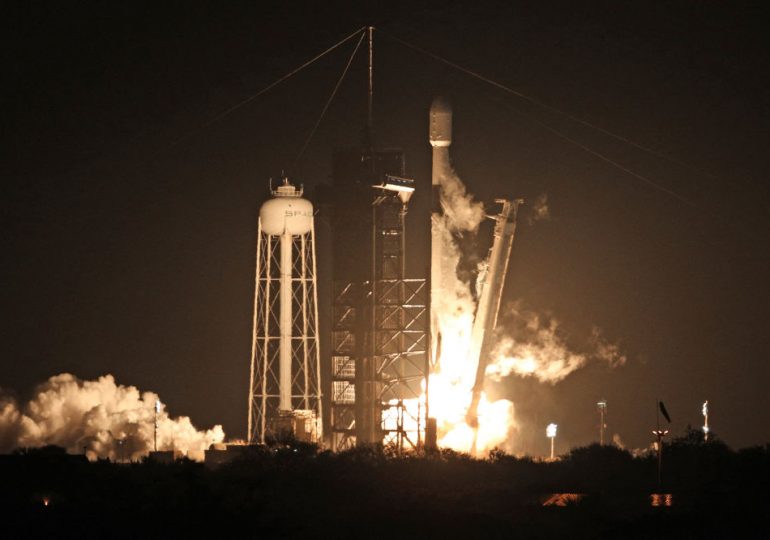Early this week, Facebook provided me with a sweet piece of serendipity when it served up a picture of the late Gene Cernan. I had taken and posted the picture in 2014, when Cernan, the last man on the moon, was being feted at the premiere of the documentary about his life, titled, straightforwardly, The Last Man On the Moon. I had gotten to know Gene well over the course of many years of reporting on the space program, and was keenly saddened when we lost him to cancer three years later.
[time-brightcove not-tgx=”true”]
But this week, on Feb. 22, Cernan made news in a bank-shot sort of way, when the Odysseus spacecraft touched down near the south lunar pole, marking the first time the U.S. had soft-landed metal on the moon since Cernan feathered his lunar module Challenger down to the surface of the Taurus-Littrow Valley on Dec. 11, 1972. The networks made much of that 52-year gulf in cosmic history, but Odysseus was significant for two other, more substantive reasons: it marked the first time a spacecraft built by a private company, not by a governmental space program, had managed a lunar landing, and it was the first time any ship had visited a spot so far in the moon’s south, down in a region where ice is preserved in permanently shadowed craters. Those deposits could be harvested to serve as drinking water, breathable oxygen, and even rocket fuel by future lunar astronauts.
“Today, for the first time in more than a half century, the U.S. has returned to the moon,” said NASA Administrator Bill Nelson in a livestream that accompanied the landing. “Today, for the first time in the history of humanity, a commercial company and an American company launched and led the voyage up there.”
Nelson’s enthusiasm was not misplaced. The six Apollo lunar landings might have been epochal events, but they were also abbreviated ones. The longest stay any of the crews logged on the surface was just three days by Cernan and his lunar module pilot Harrison Schmitt. The shortest stay was less than 21 hours, by Neil Armstrong and Buzz Aldrin during the Apollo 11 mission, the first lunar landing, in 1969. That so-called flags and footprints model was fine for the days when the U.S. lunar program was mostly about doing some basic spelunking and, not for nothing, beating the much-feared Soviet Union at planting a flag in the lunar regolith.
But the 21st-century moon program is different. Ever since NASA established its Artemis program in 2017, the space agency has made it clear that the new era of exploration will be much more ambitious. The goal is in part for American astronauts to establish at least a semi-permanent presence on the moon, with a mini-space station known as Gateway positioned in lunar orbit, allowing crews to shuttle to and from the surface. NASA also plans to create a south pole habitat that the crews could call home. And all of this will be done by a much more diverse corps of astronauts, with women and persons of color joining the all-white, all-male list of astronauts who traveled to the moon the first time around.
There is, however, a catch: money. In the glory days of Apollo, NASA funding represented 4% of the total federal budget; now it’s just 0.4%. That means taking the job of designing and building spacecraft off of the space agency’s plate and outsourcing it to private industry, the way SpaceX now ferries crews to the International Space Station, charging NASA for the rides the way it charges satellite manufacturers and other private customers. The Commercial Crew Program, of which SpaceX is a part, was established in 2011, and has been a rousing success, so much so that, in 2018, NASA took things a step further, announcing the Commercial Lunar Payload Services (CLPS) program, similarly outsourcing the delivery of equipment that astronaut-settlers will need.
CLPS, however, stumbled out of the gate. On Jan. 8 of this year, the Peregrine lander, built by Pittsburgh-based Astrobotic Technology, was launched to a similar lunar region that Odysseus targeted, carrying 20 payloads, including mini-rovers, a spectrometer designed to scour the soil for traces of water, and another to study the moon’s exceedingly tenuous atmosphere. Peregrine was not destined to make it out of Earth’s orbit, however, after an engine failure stranded it—leaving the ship to plunge back into the atmosphere 10 days after launch.
“There will be some failures,” Astrobotic CEO John Thornton told TIME before the Peregrine mission launched. “But if even half of these missions succeed, it is still a wild, runaway success.”
Odysseus landed in that second, happier column. Built by Houston-based Intuitive Machines, the spacecraft carries six science instruments, including stereoscopic cameras, an autonomous navigation system, and a radio wave detector to help measure charged particles above the surface—critical to determining the necessary sheathing in an eventual habitat. NASA has at least eight other CLPS missions planned, including two more by Intuitive Machines and another by Astrobotic, through 2026. After that, the program is expected to go on indefinitely—supplying lunar bases for as long as Artemis has astronauts on the moon.
Just when those explorers will arrive is unclear. The Artemis II mission, which was expected to take astronauts on a circumlunar journey in November of this year, has been postponed until September of 2025, due to R&D issues in both the Space Launch System moon rocket and the Orion spacecraft. Artemis III, set to be the first landing since the Apollo 17 astronauts trod the regolith, will likely not come until 2026 at the earliest.
That 52 year wait would not have sat well with that long-ago crew. In the same year in which they flew, the National Football League’s Miami Dolphins made a less consequential history of their own, when they became the first and so far only team to go through an entire season undefeated. The surviving members of that legendary squad have waited out the seasons that have followed, pulling for their record to stand—and conceding relief when the final undefeated team at last records a loss. Cernan, for his part, wanted nothing to do with his own “last man” record. “We leave here as we came and, God willing, we shall return, with peace and hope for all mankind,” he said before he climbed back up the ladder of his lunar module and left the moon behind. The success of Odysseus does not make the fulfillment of Cernan’s wish imminent, but it does nudge it closer.
Leave a comment








